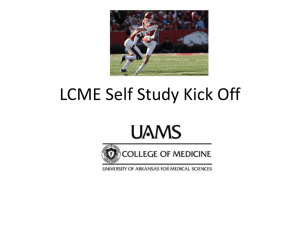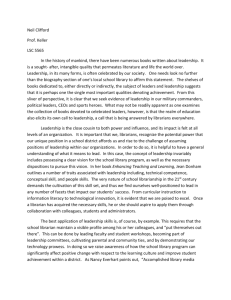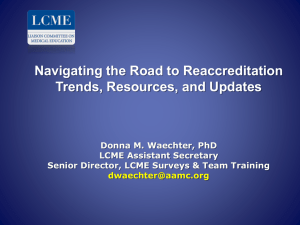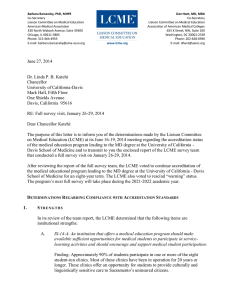Panel-Space_Planning_20120622
advertisement
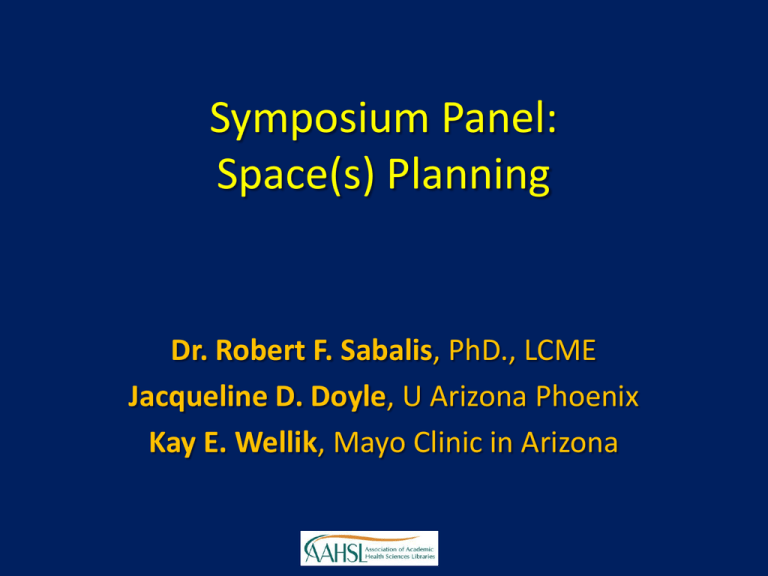
Symposium Panel: Space(s) Planning Dr. Robert F. Sabalis, PhD., LCME Jacqueline D. Doyle, U Arizona Phoenix Kay E. Wellik, Mayo Clinic in Arizona Questions & Unknowns • Impact of curricular changes/evolution • Move from print to e-resources • Attending to student (and faculty) preferences/learning & studying styles • Budgets • Collaborations • Types of spaces in library • Administrative mandates • Non “librarian” roles • LCME Mandates What LCME Mandates ER-11. An institution that provides a medical education program must provide ready access to… Well-maintained library facilities sufficient in size, breadth of holdings, and technology to support its educational and other missions A Well-Maintained Library Facility • • • • • • • • • • Total user seating Number of small-group study rooms, number of public workstations; number of computer classrooms; Number of computers or workstations in computer classrooms Total current journal subscriptions (all formats) total journal subscriptions (print only) Number of book titles (all formats); number of book titles (print only) Number of databases Number of external documents provided to users Total collection expenditures Campus-wide or consortium agreements Whether the library interacts with other university and affiliated hospital libraries and the means by which those interactions take place. The name and year of appointment for the director of the principal library for the medical school and the title of the person to whom the library director reports. Note any other schools or programs served by the library • • • • • • Number of professional staff; Number of technical and paraprofessional staff; Number of clerical support staff; Number of student or hourly support staff Mechanisms used to ensure the ongoing development and maintenance of the professional skills of staff members in the library. Means by which the library supports medical education. Means by which the library addresses institutional faculty and student needs for quiet and collaborative group and individual study and provides public access workstations and printing Hours during which the library building and the public access computers are available Methods used to provide faculty members, residents, and students with access to library resources from off-campus sites AAHSL Activities • Suggestions for successful completion of the LCME Institutional Self Study are found HERE. • We have made suggestions for strengthening the database questions and are awaiting word. Curricular Changes • Group Learning • Partnerships of librarians and IT/Informatics professionals • New learning spaces/studios • Increased e-learning and teaching • Perhaps more reliance on e-texts and resources • Work with curricular leaders! • Value placed on info literacy and EBM tools • Providing remote access/distance learning Do we still need Stacks?? • • • • Smaller overall footprint fewer stacks Space designated for a variety of study areas More collaborative spaces Emphasis on natural light and comfortable seating • Some students (still) prefer studying in the library – added value ?? Are new amenities called for? • Café? • Presentation Practice Studio? (UMAB) • More flexible teaching/learning spaces? – e.g., learning studios • New types of seating/furniture? • Ubiquitous Wi-Fi a given • Increased power Clienteles Served • More than medicine – Pharmacy – Nursing – Public Health – PhD Researchers – Other allied health, e.g., PT, OT, other? – Physician Assistants – More Library Monopoly? • No – students study everywhere…what added value does the library offer that Starbucks does not? One Case Phoenix Biomedical Campus Library • 1992 as University of AZ COM regional campus for last two/clinical years only • 2006 opened 4-year campus, still regional – Began with “integrated” curriculum • 2012 received preliminary status as separately accredited COM Evolution • 2006 – 24 MS-Is, 40 faculty (2 librarians) – 1,100 sf library • 2007-2011 – 48 MS-Is, 1 librarian, 55 faculty • 2012 – 80 MS-Is, 2 librarians – 13,700 sf library as of July 5 in new HSEB! – Partnerships • External - NAU , 1 librarian soon • Internal – CMS, Scholarly Projects, Digital Repository… Evolution Phoenix Biomedical Campus Expansion2012 14 Things to pay attention to! • Impact of curricular changes/evolution • Move from print to e-resources • Attending to student (and faculty) preferences/learning & studying styles • Budgets • Collaborations • Types of spaces in library • Administrative mandates, i.e., $ • Non “librarian” roles • LCME Mandates • Talk to colleagues! Contact us • Robert F. Sabalis, Ph.D. Assistant LCME Secretary, and Director, LCME Surveys and Team Training; rsabalis@aamc.org • Jacque Doyle, MS, AHIP, FMLA Head Librarian, University of Arizona College of Medicine Phoenix, jddoyle@u.arizona.edu; 602-827-2062/31 Blog: http://ahslphoenix.wordpress.com/ • Kay E. Wellik, MLS, AHIP, FMLA Director, Library Services & Assistant Professor of Medical Informatics, Mayo Clinic in Arizona; wellik.kay@mayo.edu 480-301-4422

